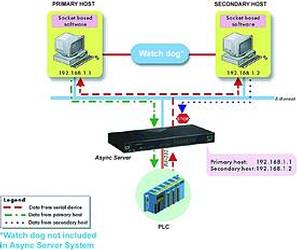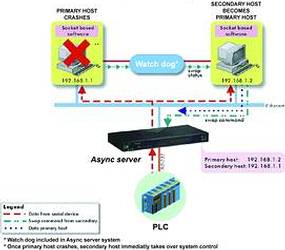
The MOXA CN2500 async server is an advanced and reliable serial-to-Ethernet device server that communicates with hosts over a TCP/IP Ethernet, giving system administrators centralised control of many distributed devices.
MOXA is now offering a dual-host redundant data acquisition system (DRDAS) for async server that provides the industrial automation industry with a highly reliable redundant data acquisition and monitoring system that can be used in mission-critical environments.
In mission-critical industries, such as telecommunications, oil refining, electric power generation, chemical manufacturing, energy distribution, and monitoring of reservoirs and dams, overall system reliability is the most important consideration. In order to maintain high reliability and prevent disaster and financial loss, the automation system is required to be fault-tolerant and must able to quickly recover from system shutdowns during any 24 h period of operation.
The system is designed to guard against data acquisition failures caused by an unresponsive host. According to statistics, the most critical factor affecting system reliability is the host PC itself. Various mechanical components, such as the fan and hard drive, are easily damaged, leading to a suspension of the host's operating system. With the help of DRDAS and the robust MOXA async server, dual-host configuration works to significantly increase the overall reliability of a data acquisition system.

How DRDAS works
Figure 1 illustrates normal operation, during which the primary host can send and receive signals to and from serial devices attached to async server. As illustrated in the control status swap figure (Figure 2), the secondary host takes over full control once the primary host stops responding.

DRDAS works by allowing dual-hosts, designated primary and secondary, to simultaneously receive serial port data from the same async server. The primary host can effectively both read and write data from attached serial devices using TCP/IP socket-based software, and although the secondary host can read data from connected devices, async server blocks signals that the secondary host writes to the devices.
DRDAS works in conjunction with user-supplied watchdog hardware and software that is used to establish a dedicated alive-check link between the two hosts. The watchdog alerts the secondary host as soon as the primary host's OS has stopped responding. Depending on the sophistication of the watchdog system being used, the alert could be issued from anywhere between a few microseconds to one or two seconds after the crash occurs.
As soon as the secondary host learns that the primary host has crashed, the secondary host sends a series of commands to async server that 'swap' control-right to the secondary host. This allows the secondary host to take over full data acquisition and monitoring duties. Once the primary host is back up and running, it sends a series of commands that 'swap' control right back to the primary host, allowing the primary host to resume full data acquisition and monitoring.
| Tel: | +27 11 781 0777 |
| Email: | [email protected] |
| www: | www.rjconnect.co.za |
| Articles: | More information and articles about RJ Connect |

© Technews Publishing (Pty) Ltd | All Rights Reserved